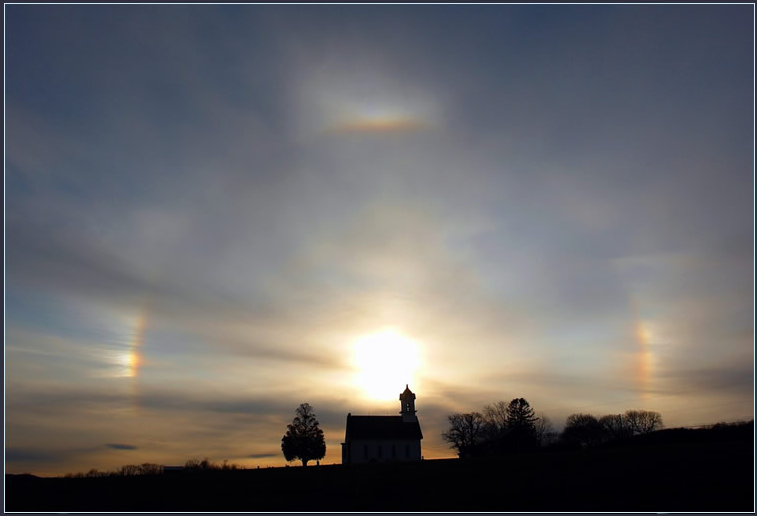Easter Halos
Easter Halos: A Captivating Atmospheric Phenomenon
Easter Halos, also known as ice halos, are a captivating atmospheric phenomenon that occurs when sunlight interacts with ice crystals in the atmosphere. These stunning displays of light can be observed around the sun or moon and are often characterized by a variety of colorful and intricate optical phenomena.
The Formation of Easter Halos
The formation of Easter Halos begins with the presence of high-altitude clouds that contain ice crystals. These ice crystals act as tiny prisms, bending and refracting the sunlight that passes through them. As a result, the light is dispersed into its constituent colors, creating a mesmerizing display of hues.
One of the most common types of Easter Halos is the 22° halo, which appears as a circular ring around the sun or moon. This halo is caused by the refraction of light through hexagonal ice crystals in the atmosphere. Additionally, an upper tangent arc may be visible above the halo, adding an extra layer of beauty to the phenomenon.
The Mystery of Sundogs
In some instances, bright areas can be observed to the left and right of the sun within the halo display. These bright spots are known as sundogs or parhelia and are produced by plate crystals with large tilts. However, determining whether these bright areas are sundogs or simply bright parts of the 22° halo can be challenging.
Sundogs are formed when sunlight is refracted by horizontally oriented ice crystals, creating two bright spots on either side of the sun. These spots are often accompanied by a faint halo that connects them to the main 22° halo. The appearance of sundogs adds an extra layer of complexity and beauty to the overall Easter Halo phenomenon.
The Role of Weather Conditions
The occurrence of Easter Halos is closely tied to specific weather conditions. Typically, these halos are more likely to be observed in colder regions where ice crystals are abundant in the atmosphere. Therefore, areas with frequent snowfall or high-altitude clouds are prime locations for witnessing these mesmerizing displays.
Furthermore, the presence of thin, wispy cirrus clouds is often associated with the formation of Easter Halos. These clouds are composed of ice crystals and can create an ideal environment for the refraction of sunlight, leading to the formation of intricate halo patterns.
The Cultural Significance of Easter Halos
Easter Halos have captivated humans for centuries and have often been associated with mystical or religious significance. In various cultures, these optical phenomena have been interpreted as signs of good fortune, divine intervention, or even celestial messages.
In Christian traditions, the appearance of a halo around the sun during Easter holds particular significance. It is seen as a symbol of the divine presence and a reminder of the resurrection of Jesus Christ. This adds an additional layer of wonder and reverence to the already enchanting Easter Halo displays.
Capturing the Beauty of Easter Halos
Photographers and sky enthusiasts are often drawn to the mesmerizing beauty of Easter Halos. Capturing these ethereal displays can be a challenging yet rewarding experience. The key lies in understanding the optimal conditions for observing halos and having the right equipment to capture their intricate details.
To photograph Easter Halos, it is recommended to use a DSLR camera with a wide-angle lens to capture the entire halo display. Additionally, using a tripod can help stabilize the camera and ensure sharp images. Experimenting with different exposure settings and filters can also enhance the colors and details of the halo.
Appreciating Nature's Spectacle
Easter Halos serve as a reminder of the extraordinary wonders that can be found in nature. These captivating optical phenomena showcase the interplay between sunlight and ice crystals, resulting in breathtaking displays of light and color. Whether observed as a religious symbol or simply appreciated for their aesthetic beauty, Easter Halos continue to inspire awe and wonder in those fortunate enough to witness them.
So, the next time you find yourself gazing at the sky on an Easter day or any other day, keep your eyes open for the enchanting display of an Easter Halo. It is a reminder that even in the vastness of the atmosphere, there is a hidden world of beauty waiting to be discovered.

Easter Halos
Imaged by Linda Sweger
Image ©Linda Sweger, shown with permission.
"I captured this colorful icy sun halo display on Good Friday about 60 minutes before Sunset as we were driving home from Dauphin Co. in Central Pennsylvania. These clouds were the leading edge of a minor snow event the next morning."
A 22° halo circles the sun and is topped by an upper tangent arc. Bright areas to the sun's left and right might be tall sundogs produced by plate crystals with large tilts. They could also simply be bright parts of the 22° halo. It's hard to say.
Key to frequent halos
Note: this article has been automatically converted from the old site and may not appear as intended. You can find the original article here.
Reference Atmospheric Optics
If you use any of the definitions, information, or data presented on Atmospheric Optics, please copy the link or reference below to properly credit us as the reference source. Thank you!
-
<a href="https://atoptics.co.uk/blog/easter-halos/">Easter Halos</a>
-
"Easter Halos". Atmospheric Optics. Accessed on April 20, 2024. https://atoptics.co.uk/blog/easter-halos/.
-
"Easter Halos". Atmospheric Optics, https://atoptics.co.uk/blog/easter-halos/. Accessed 20 April, 2024
-
Easter Halos. Atmospheric Optics. Retrieved from https://atoptics.co.uk/blog/easter-halos/.